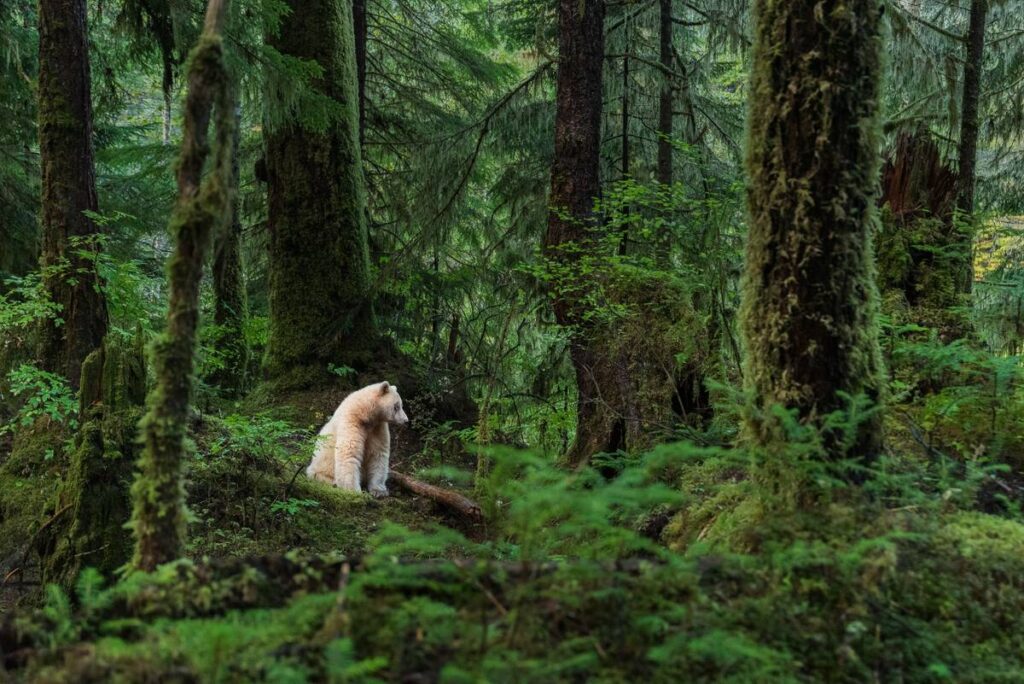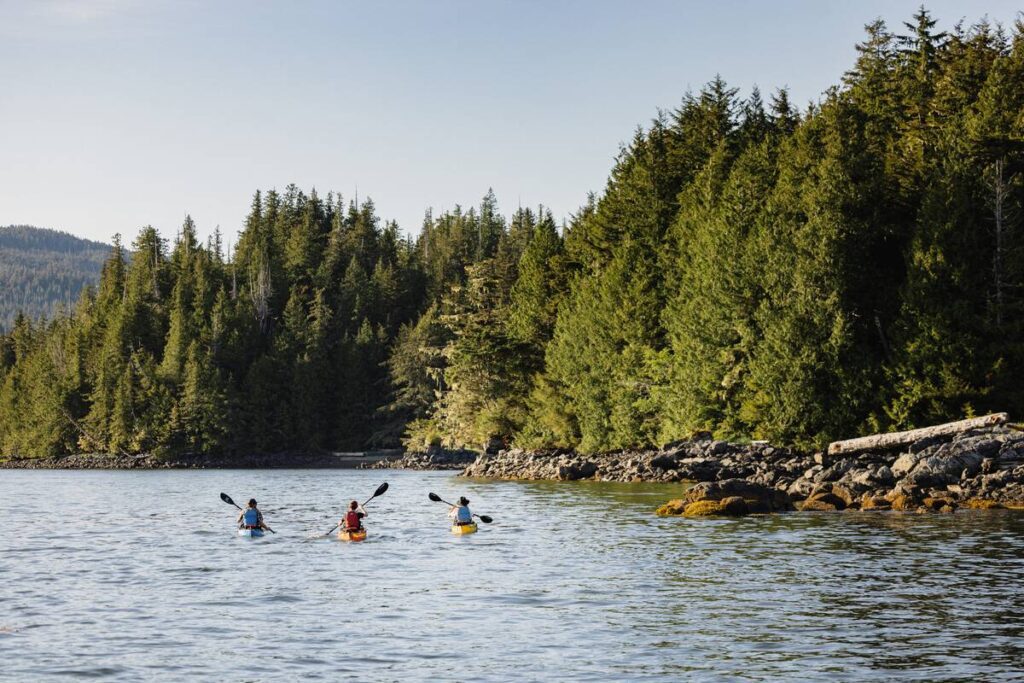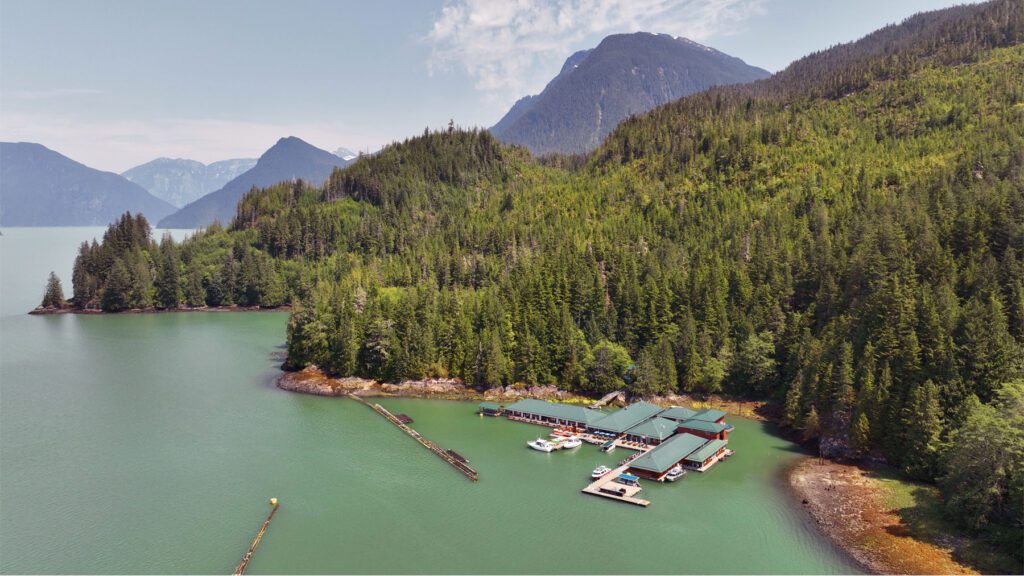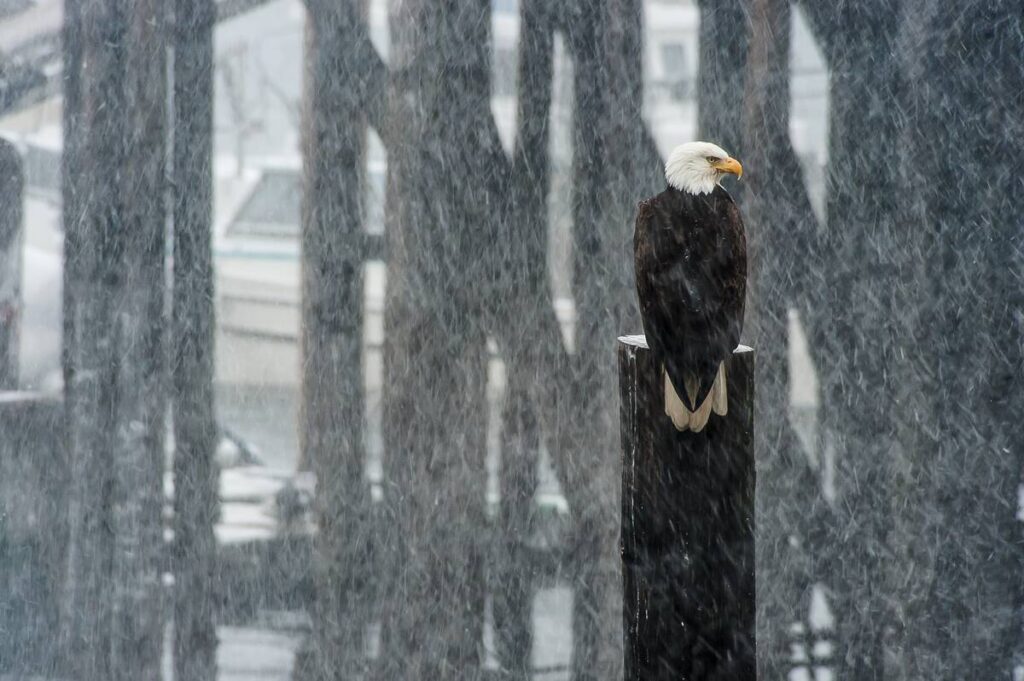Recently updated on October 14th, 2025 at 01:25 am
Draped over Canada’s Pacific coast in a patchwork of emerald, teal, and earthy tones, the Great Bear Rainforest is a vast, temperate rainforest humming with life – and with adventure possibilities. These wild lands are the ancestral home of 26 First Nations, whose neighbours include the mysterious spirit bear, coastal wolf, grizzly, and the wandering whales of the Great Bear Sea – where towering kelp forests form their own type of canopy. But as peaceful as this part of the world may be, you won’t have time to be bored here, with so many ways to explore and engage with nature, wildlife and culture. Read on to discover them all and more in our ultimate guide to British Columbia’s Great Bear Rainforest.
Quick Facts About the Great Bear Rainforest
The Great Bear Rainforest spans 6.4 million hectares of temperate rainforest along British Columbia’s remote central and north coast, running from Knight Inlet and Bute Inlet in the south, up to the Alaska border in the north. In between, glacier-carved fjords, verdant river valleys, towering mountains and more than a thousand islands in the Great Bear Sea all add up to a wilderness as ancient as it is lush: it formed some 10,000 years ago and is still home to 1,000-year-old cedars. Around 18,000 people live throughout the rainforest – most of them in small communities like Bella Coola, Bella Bella, Prince Rupert, Kitimat, and Klemtu, which are accessed by regional flights from Vancouver. But they’re grossly outnumbered by the wildlife here, with the annual salmon returning each year to feed countless animals and, ultimately, the forest itself.


Best Time to Visit the Great Bear Rainforest
Most wilderness lodges operate from May or June through to October, and the peak season for wildlife-viewing runs from late August to early October, when salmon runs draw grizzlies, black bears and the rare spirit bear to river mouths, and coastal wolves may be seen hunting on remote beaches.
Spring (April-May) brings migrating grey and humpback whales and seabirds like rhinoceros auklets, marbled murrelets and sandhill cranes. Summer (June to mid-August) brings highs of 15-18 °C, bears dine on sedge grass and berries while humpback whales cruise offshore. Autumn days average 12-15 °C, with September bringing 200-300mm of rain for the month, but excellent bear sightings as the salmon run heats up. Winter (late November to March) is largely off-limits due to storms, heavy rain, transport disruptions and lodge closures.
How to Get to the Great Bear Rainforest
Technically, it is possible to travel through smaller sections of the rainforest independently – communities like Bella Coola and Kitimat are linked to the provincial highway network – but most of the region is roadless and accessible only by boat or floatplane, so your best bet is to choose a lodge-based stay. Getting to remote lodges usually involves a couple of short but scenic flights. From Vancouver International Airport, you’ll fly to a regional hub such as Bella Coola, Bella Bella, Port Hardy or Campbell River. From one of these gateways, you’ll continue by seaplane or boat transfer to your accommodation, with both modes usually arranged by the lodge itself.


Top Places to Visit
Here, just a handful of the Great Bear Rainforest’s key hotspots for nature, culture and wildlife.
Spirit Bear Conservancy
This is the stronghold of the rarest bear subspecies in the world – the white-furred Kermode bear, or spirit bear, a unique variant of the black bear found only in coastal British Columbia – and experts believe there are fewer than 400 of them on Earth. Along with being disarmingly photogenic, its cultural and ecological value are immeasurable: the spirit bear holds deep significance in Indigenous oral histories, and its presence signals a healthy, intact ecosystem. This conservancy, co-managed by BC Parks and the Kitasoo/Xai’xais Nation, spans some 103,000ha of old-growth rainforest, salmon-filled streams, and rugged coastlines, and is also home to black bears, grizzlies, coastal wolves, humpback whales, sea otters, bald eagles, and countless seabirds. You can explore this remote sanctuary as part of a guided lodge-based holiday: Adventure World’s Spirit Bears & First Nations Culture holiday pairs guided spirit bear tracking with cultural experiences for a unique insight into this raw wilderness.


Kitasoo/Xai’xais Territory
Centred on the village of Klemtu on the central coast, the Kitasoo/Xai’xais Territory spans roughly 4,000km² across islands, fjords and rainforest, home to old-growth cedar and spruce, salmon-bearing rivers and marine channels frequented by whales, as well as spirit bears, coastal wolves, grizzlies and black bears. It’s typically reached by flying into Bella Bella, then continuing by seaplane or boat.
The Kitasoo/Xai’xais people have lived here for thousands of years – today the Nation is nearly 520 strong, with around 320 community members living in Klemtu – and under their stewardship, it continues to flourish. The community co-manages the Kitasoo Spirit Bear Conservancy with BC Parks and runs the Spirit Bear Lodge, offering guided wildlife viewing and cultural experiences that reflect their values of respect and reciprocity with the land and sea.
Tweedsmuir Provincial Park
Accessible by road from Bella Coola, Tweedsmuir Provincial Park bridges the Great Bear Rainforest’s temperate ecosystems with alpine and subalpine habitats to create British Columbia’s largest protected area. The park is bisected by the Atnarko and Bella Coola Rivers, both renowned for their salmon runs and the bears they attract each autumn, but you’ll also find mountain goats, moose and wolves throughout the park. And the ecosystems change dramatically the higher you go into the Coast Mountains – from moss-draped old-growth in the valleys to wildflower meadows and icefields above – making Tweedsmuir a top spot for hiking, wildlife spotting and kayaking.


What to Do in the Great Bear Rainforest
This epic wilderness is purpose-built for adventures big and small, with every outing bringing a new way to connect to its natural highlights and culture.
Wildlife viewing and bear watching
Throughout the region, wildlife viewing is a painstakingly managed, fully guided experience designed to protect both people, animals and their habitat – independent wildlife excursions aren’t allowed in sensitive areas, and you must always stay with your guide. You might spend time in a purpose-built hide or on raised boardwalks overlooking salmon streams, offering discreet vantage points as grizzlies, black bears and spirit bears feed. Whale watching is typically done from small, powered boats and led by experienced naturalists or Indigenous guides who share their ecological expertise. Such excursions generally last from two to four hours, with many lodges offering full day excursions or morning and afternoon sessions. While early morning and late afternoon are peak times for bear viewing, whales and other marine life can be found around the clock.
Hiking and nature tours
Guided rainforest hikes range from gentle interpretive meanders to challenging alpine climbs. Short lodge-based walks are often one-to-three hours long, are usually on well-worn trails or boardwalks and your naturalist guides will explain the connections between the ecosystem’s land, water and wildlife, answer any questions, reveal key photographic spots and carry bear protection.
More demanding half- or full-day hikes can take you up steep slopes or along coastal ridges, and you can usually pick up a guide for these in Bella Coola and Tweedsmuir Provincial Park if they aren’t offered by your lodge. Up for a harder challenge? The Alexander MacKenzie Heritage Trail is the most famous multi-day route through in the region.
Cultural Experiences with Indigenous Communities
Cultural experiences here are led by Indigenous hosts whose families have lived in the Great Bear Rainforest for thousands of years. Depending on where you stay, as part of your lodge’s program you might be welcomed into a traditional community Big House to hear songs, stories and histories passed down through generations, and carving and craft workshops are sometimes offered.


Kayaking and Coastal Exploration
Exploring the rainforest from the water brings a perspective you just can’t get on land. Motorised coastal tours, often guided by naturalists, take you through fjords lined with towering rainforest, past sea lion haul-outs, and across channels frequented by whales. And kayaking brings you even closer to the action: prime paddling areas include the sheltered inlets around Bella Bella, the islands of the Spirit Bear Conservancy, and the estuaries near Bella Coola. Many lodges include guided kayak excursions in their programs, supplying all equipment and safety gear.
Where to Stay
While you’ll find a handful of remote lodges and eco-resorts scattered across the region, each of the following stays present their own stellar blend of scenic locations, cultural immersions, guided excursions and comfy accommodations – with all your meals covered.
Spirit Bear Lodge
Located in Klemtu and operated by the Kitasoo/Xai’xais First Nation, Spirit Bear Lodge is the only dedicated spirit bear viewing lodge in the world, perched right on the edge of the Spirit Bear Conservancy. The lodge itself offers a laidback stay with ocean-facing rooms, a communal dining hall, and evening cultural programs, and a typical package runs four to seven nights. Most excursions are included, too, and might include bear-watching by boat, kayak tours or cultural experiences. You can stay at this authentic First Nations lodge as part of an authentic MAKE TRAVEL MATTER® experience with Adventure World.


Great Bear Lodge
This award-winning floating lodge offers an intimate atmosphere and is carbon-neutral, powered by wind and solar, with its low-impact ethos and commitment to sustainable bear tourism making it an excellent choice for a MAKE TRAVEL MATTER® stay. Its location in prime grizzly habitat brings unforgettable encounters, with a typical stay including two daily excursions, such as wildlife watching from viewing platforms, backwater rowboat cruises and guided interpretive walks.
Knight Inlet Lodge
Located deep within British Columbia’s Great Bear Rainforest and only reachable by floatplane, Knight Inlet Lodge is owned by Indigenous partnership of five First Nations: the Da’naxda’xw Awaetlala, Mamalilikulla, Tlowitsis, Wei Wai Kum, and K’ómoks, who are all stewards of the lodge’s traditional territories in British Columbia’s Great Bear Rainforest, and is a MAKE TRAVEL MATTER® stay. Floating among the serene waters of Glendale Cove, the lodge is surrounded by towering mountains and ancient forests that teem with life. It’s grizzly bear country where you can often spot them fishing for salmon on the riverbanks, but is also home to eagles, seals and even orcas that glide through the fjords. Combining sustainable comfort and the forests of British Columbia, Knight Inlet Lodge is a chance to experience wild Canada up close. Adventure World offers access via its Grizzlies of the Great Bear Rainforest holiday.


Tweedsmuir Park Lodge
Originally built in 1931, Tweedsmuir Park Lodge is one of the oldest wilderness lodges in British Columbia, renowned for its exceptional bear viewing and heli-skiing heritage. Located just outside the entrance to Tweedsmuir Provincial Park near Bella Coola, it’s accessible by both road and air. Here you can stay in timber-framed chalets and make use of the central main lodge’s dining room, lounge, hot tub and sauna. Packages generally span three to seven nights, including full board and guided excursions.
Farewell Harbour Lodge
Set on the edge of Berry Island and overlooking the Broughton Archipelago, Farewell Harbour Lodge is a true coastal wilderness retreat that showcases the best of Canada’s wildlife. From grizzly bears foraging along the river estuaries to humpback whales spouting for air among the fjords. Days are filled with guided bear-viewing excursions and marine safaris while evenings are all about fireside stories and locally inspired cuisine.


Klahoose Wilderness Resort
Located in the tranquil Desolation Sound region of British Columbia, Klahoose Wilderness Resort is a deeply cultural and immersive wilderness resort on the lands of the Klahoose First Nation. Join local guides and learn the Indigenous stories and traditions that have shaped the land for generations, look for grizzly bears and explore waterfalls by boat and kayak. With a strong sense of place and warm Klahoose hospitality this resort offers a one-of-a-kind connection with nature and the spirit of the coast.
What to Pack for Your Trip
Your goal should be to pack light, but right – you don’t want to be overloaded with non-essentials, but you need to be prepared. Start with layered clothing – fresh mornings and afternoon drizzles mean temperatures can fluctuate throughout the day, especially on the water. Many lodges provide muck boots and waterproof gear, but if you need to BYO, pack a waterproof shell jacket and trousers, and weatherproof hiking boots. Summer brings plenty of bugs, so an odourless insect repellent; as will sunscreen, a sun hat, and a reusable water bottle. Plus, a lightweight, soft-sided backpack or duffel will help you comply with floatplane weight restrictions and the limited space available on transfer boats.
Respectful and Sustainable Tourism Practices
A journey into the Great Bear Rainforest comes with an unspoken understanding: to treat the wildlife and landscapes here with the same care that has sustained them for millennia. That’s why the best encounters are always on the animals’ terms – binoculars and a long-lens camera will let get you close without intruding, while staying as quiet as possible helps ensure their routines remain undisturbed. Bears rely on uninterrupted feeding to prepare for hibernation, and ongoing distractions can jeopardise their wellbeing. That’s just one reason why guides play such a central role in this wilderness. Their knowledge of animal behaviour shapes your excursion, and their policing of safety protocols ensure it treads right. Plus, these guides are trained and equipped to respond in the rare case of an emergency – so all you need to do is trust their judgement.
A mindful approach should continue back at your lodge too, where you and your hosts work together to protect this fragile environment. Adventure World carefully vets its partners to ensure they share our travel-with-purpose ethos, namely through our MAKE TRAVEL MATTER® experiences – a sustainability initiative created in partnership with The TreadRight Foundation and The Travel Corporation to support the United Nations’ Global Goals of Sustainable Development. To learn more about how to reduce your impact and choose the best possible operators when you’re travelling independently, see our story How to Travel More Sustainably: Practical Tips for Every Traveller.


Final Tips for Planning Your Great Bear Rainforest Adventure
While bears are the main event in this spectacular part of the world, this is also the domain of the mysterious coastal wolf, so don’t miss your chance to see them. As they’re super elusive, your best possible opportunity to see them will be on a specialised guided journey, like Adventure World’s seven-day Searching For Coastal Wolves adventure.
It’s also well worth making extra time to explore further afield in British Columbia because the province is a true playground for nature and wildlife lovers; think iconic train journeys through the Rockies, Island Wildlife and Adventure on Vancouver Island, and more.
But whether you choose to extend your travels further afield or make the Great Bear Rainforest your main event, bring along your curiosity, wonder and flexibility – because in this wild frontier, every day is an adventure.
